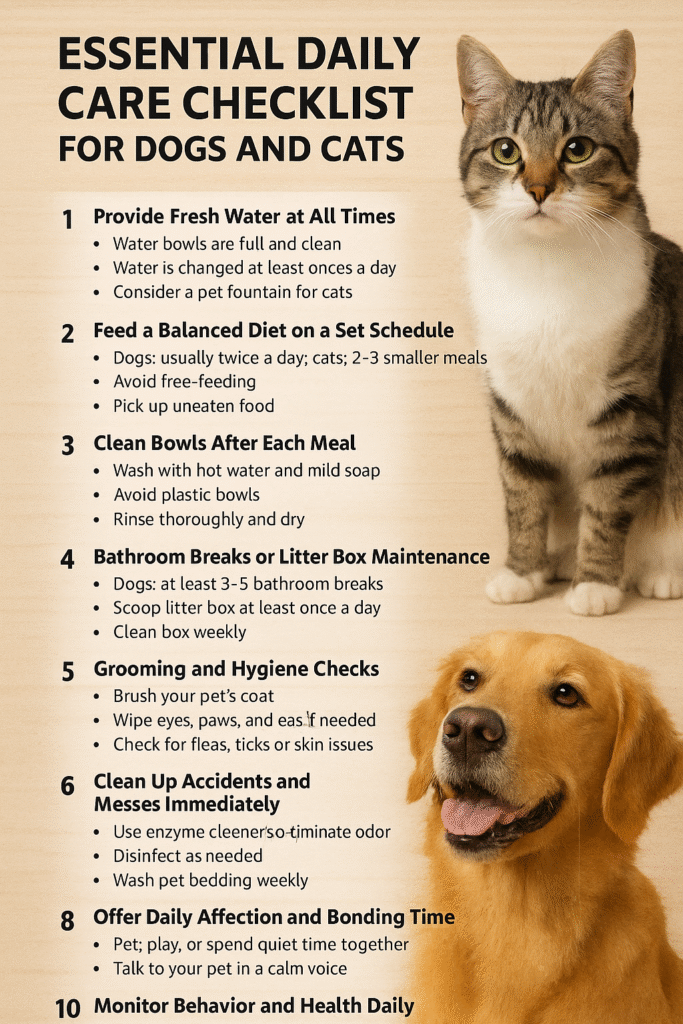Taking care of a dog or cat isn’t just about love and cuddles—it’s also about building a consistent daily routine that covers their basic needs. Just like people, pets thrive on structure. A well-maintained routine promotes good health, prevents behavioral problems, and strengthens the bond between you and your animal companion.
Use this complete daily checklist to ensure your pet is happy, healthy, and well cared for—every single day.
1. Provide Fresh Water at All Times
Hydration is critical for your pet’s organ function, digestion, and energy levels. Make sure:
- Water bowls are full and clean
- Water is changed at least once a day (more in hot weather)
- Multiple bowls are available in larger homes
For cats, consider a pet fountain to encourage more drinking.
2. Feed a Balanced Diet on a Set Schedule
Feeding time should be consistent to avoid obesity or digestive issues.
- Dogs typically eat twice a day (morning and evening)
- Cats may benefit from two to three smaller meals
- Avoid free-feeding unless advised by your vet
- Pick up uneaten food to prevent spoilage
Use a measuring cup to avoid overfeeding and adjust portions as needed.
3. Clean Bowls After Each Meal
Food and water dishes should be cleaned daily to avoid bacteria buildup.
- Wash with hot water and mild soap
- Avoid plastic bowls (which can harbor bacteria in scratches)
- Rinse thoroughly and dry before reuse
Clean bowls contribute to better oral and digestive health.
4. Bathroom Breaks or Litter Box Maintenance
Keep your pet’s bathroom routine clean and stress-free.
For dogs:
- Offer bathroom breaks at least 3–5 times a day
- Morning, after meals, before bed, and after play or naps
- Praise and reward appropriate potty behavior
For cats:
- Scoop litter boxes at least once a day
- Clean box thoroughly once a week
- Keep one litter box per cat, plus one extra
Cleanliness encourages consistent use and prevents indoor accidents.
5. Exercise and Play
Physical activity keeps your pet fit and mentally stimulated.
- Dogs: Daily walks (15–60 minutes depending on breed), plus playtime or training games
- Cats: At least 10–15 minutes of active play (wand toys, chase games, climbing)
- Rotate toys regularly to maintain interest
A tired pet is a happy pet—and less likely to misbehave.
6. Grooming and Hygiene Checks
Daily grooming prevents skin issues and strengthens your bond.
- Brush your pet based on their coat type (daily for long hair)
- Wipe eyes, paws, and ears if needed
- Check for fleas, ticks, or any lumps and skin irritations
For long-haired pets, check sensitive areas like behind ears, armpits, and tail base.
7. Clean Up Accidents and Messes Immediately
Accidents happen—but swift cleanup prevents odors and repeat incidents.
- Use enzyme cleaners for pet messes to eliminate odor
- Disinfect surfaces as needed (with pet-safe products)
- Wash pet bedding weekly to maintain a clean environment
A clean space is healthier for both you and your pet.
8. Provide Comfort and Safe Spaces
Make sure your pet has a quiet, cozy place to relax.
- A bed, crate, or favorite blanket
- Positioned away from noisy areas
- For cats: add vertical space or hiding options
Respect their need for solitude—especially after meals or play.
9. Offer Daily Affection and Bonding Time
Your pet needs more than just food and care—they need love.
- Petting, brushing, or simply sitting together
- Talking to them in a calm voice
- Quiet companionship while reading, watching TV, or working
These moments of connection reduce stress and deepen trust.
10. Monitor Behavior and Health Daily
Stay alert to any changes:
- Appetite, weight, or energy level
- Bathroom habits or accidents
- Mood (aggression, hiding, clinginess)
- Physical signs like limping, shaking, or scratching
Small changes can signal early health issues—don’t wait to investigate.

Conclusion: Consistency Is the Cornerstone of Great Pet Care
Caring for a dog or cat isn’t about perfection—it’s about consistency. These small daily actions, repeated with love and care, create a healthy rhythm that keeps your pet physically and emotionally well. With this checklist as your guide, you can provide a stable, safe, and joyful life for your furry best friend.